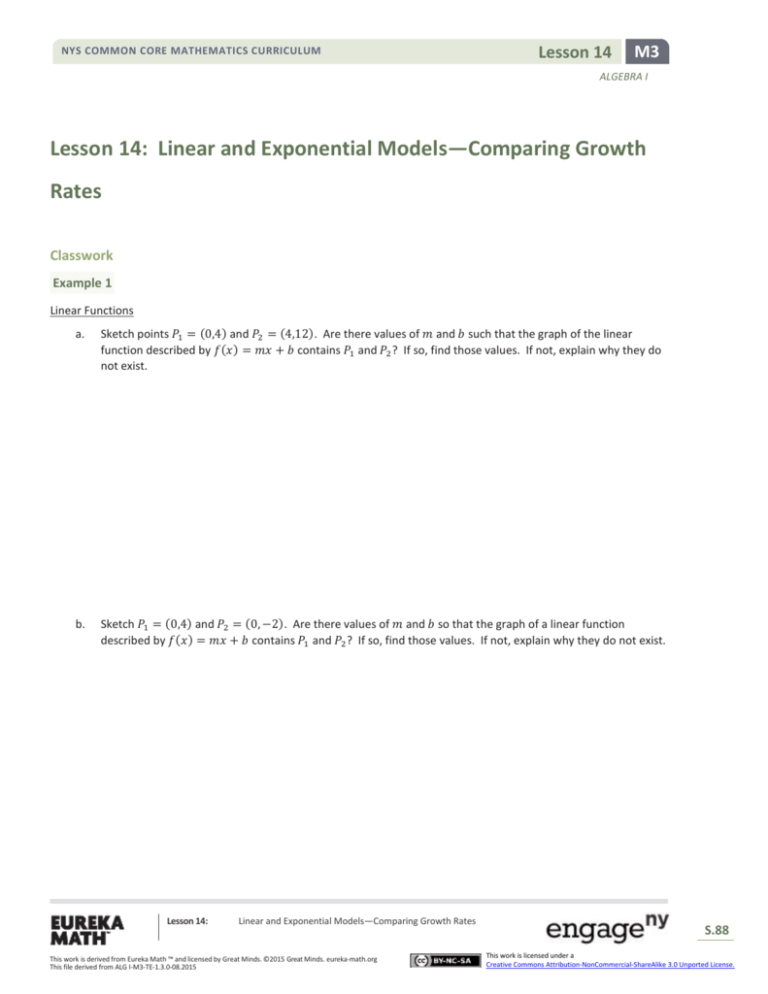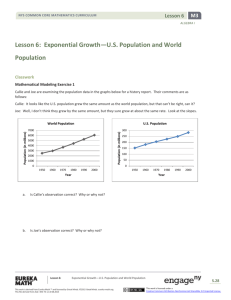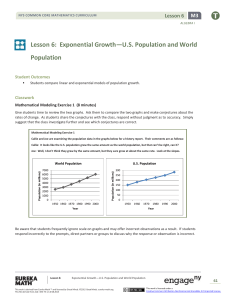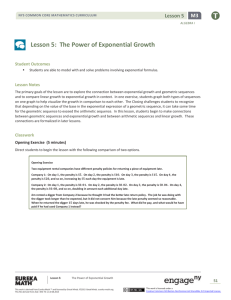Algebra I Module 3, Topic B, Lesson 14: Student Version
advertisement

NYS COMMON CORE MATHEMATICS CURRICULUM Lesson 14 M3 ALGEBRA I Lesson 14: Linear and Exponential Models—Comparing Growth Rates Classwork Example 1 Linear Functions a. Sketch points 𝑃1 = (0,4) and 𝑃2 = (4,12). Are there values of 𝑚 and 𝑏 such that the graph of the linear function described by 𝑓(𝑥) = 𝑚𝑥 + 𝑏 contains 𝑃1 and 𝑃2 ? If so, find those values. If not, explain why they do not exist. b. Sketch 𝑃1 = (0,4) and 𝑃2 = (0, −2). Are there values of 𝑚 and 𝑏 so that the graph of a linear function described by 𝑓(𝑥) = 𝑚𝑥 + 𝑏 contains 𝑃1 and 𝑃2 ? If so, find those values. If not, explain why they do not exist. Lesson 14: Linear and Exponential Models—Comparing Growth Rates This work is derived from Eureka Math ™ and licensed by Great Minds. ©2015 Great Minds. eureka-math.org This file derived from ALG I-M3-TE-1.3.0-08.2015 S.88 This work is licensed under a Creative Commons Attribution-NonCommercial-ShareAlike 3.0 Unported License. Lesson 14 NYS COMMON CORE MATHEMATICS CURRICULUM M3 ALGEBRA I Exponential Functions Graphs (c) and (d) are both graphs of an exponential function of the form 𝑔(𝑥) = 𝑎𝑏 𝑥 . Rewrite the function 𝑔(𝑥) using the values for 𝑎 and 𝑏 that are required for the graph shown to be a graph of 𝑔. c. 𝑔(𝑥) = (0,2) (−2,0.5) d. 𝑔(𝑥) = 2, 27 4 (−1,2) Example 2 A lab researcher records the growth of the population of a yeast colony and finds that the population doubles every hour. a. Complete the researcher’s table of data: Hours into study 0 Yeast colony population (thousands) 5 Lesson 14: 1 2 Linear and Exponential Models—Comparing Growth Rates This work is derived from Eureka Math ™ and licensed by Great Minds. ©2015 Great Minds. eureka-math.org This file derived from ALG I-M3-TE-1.3.0-08.2015 3 4 S.89 This work is licensed under a Creative Commons Attribution-NonCommercial-ShareAlike 3.0 Unported License. Lesson 14 NYS COMMON CORE MATHEMATICS CURRICULUM M3 ALGEBRA I b. What is the exponential function that models the growth of the colony’s population? c. Several hours into the study, the researcher looks at the data and wishes there were more frequent measurements. Knowing that the colony doubles every hour, how can the researcher determine the population in half-hour increments? Explain. d. Complete the new table that includes half-hour increments. Hours into study 0 Yeast colony population (thousands) 5 1 2 1 3 2 2 5 2 e. How would the calculation for the data change for time increments of 20 minutes? Explain. f. Complete the new table that includes 20-minute increments. Hours into study 0 Yeast colony population (thousands) 5 Lesson 14: 1 3 2 3 1 Linear and Exponential Models—Comparing Growth Rates This work is derived from Eureka Math ™ and licensed by Great Minds. ©2015 Great Minds. eureka-math.org This file derived from ALG I-M3-TE-1.3.0-08.2015 4 3 5 3 3 2 S.90 This work is licensed under a Creative Commons Attribution-NonCommercial-ShareAlike 3.0 Unported License. NYS COMMON CORE MATHEMATICS CURRICULUM Lesson 14 M3 ALGEBRA I g. The researcher’s lab assistant studies the data recorded and makes the following claim: Since the population doubles in 1 hour, then half of that growth happens in the first half hour, and the other half of that growth happens in the second half hour. We should be able to find the population at 𝑡 = 1 by 2 taking the average of the populations at 𝑡 = 0 and 𝑡 = 1. Is the assistant’s reasoning correct? Compare this strategy to your work in parts (c) and (e). Example 3 A California Population Projection Engineer in 1920 was tasked with finding a model that predicts the state’s population growth. He modeled the population growth as a function of time, 𝑡 years since 1900. Census data shows that the population in 1900, in thousands, was 1,490. In 1920, the population of the state of California was 3,554 thousand. He decided to explore both a linear and an exponential model. a. Use the data provided to determine the equation of the linear function that models the population growth from 1900–1920. b. Use the data provided and your calculator to determine the equation of the exponential function that models the population growth. Lesson 14: Linear and Exponential Models—Comparing Growth Rates This work is derived from Eureka Math ™ and licensed by Great Minds. ©2015 Great Minds. eureka-math.org This file derived from ALG I-M3-TE-1.3.0-08.2015 S.91 This work is licensed under a Creative Commons Attribution-NonCommercial-ShareAlike 3.0 Unported License. Lesson 14 NYS COMMON CORE MATHEMATICS CURRICULUM M3 ALGEBRA I c. Use the two functions to predict the population for the following years: Projected Population Based on Linear Function, 𝒇(𝒕) (thousands) Projected Population Based on Exponential Function, 𝒈(𝒕) (thousands) Census Population Data and Intercensal Estimates for California (thousands) 1935 6175 1960 15717 2010 37253 Courtesy U.S. Census Bureau d. Which function is a better model for the population growth of California in 1935 and in 1960? e. Does either model closely predict the population for 2010? What phenomenon explains the real population value? California Population Growth: 1900-2010 Population in Thousands 40,000 35,000 30,000 25,000 20,000 15,000 10,000 5,000 1880 1900 1920 1940 1960 1980 2000 2020 Year Lesson 14: Linear and Exponential Models—Comparing Growth Rates This work is derived from Eureka Math ™ and licensed by Great Minds. ©2015 Great Minds. eureka-math.org This file derived from ALG I-M3-TE-1.3.0-08.2015 S.92 This work is licensed under a Creative Commons Attribution-NonCommercial-ShareAlike 3.0 Unported License. Lesson 14 NYS COMMON CORE MATHEMATICS CURRICULUM M3 ALGEBRA I Lesson Summary Given a linear function of the form 𝐿(𝑥) = 𝑚𝑥 + 𝑘 and an exponential function of the form 𝐸(𝑥) = 𝑎𝑏 𝑥 for 𝑥 a real number and constants 𝑚, 𝑘, 𝑎, and 𝑏, consider the sequence given by 𝐿(𝑛) and the sequence given by 𝐸(𝑛), where 𝑛 = 1,2,3,4, …. Both of these sequences can be written recursively: 𝐿(𝑛 + 1) = 𝐿(𝑛) + 𝑚 and 𝐿(0) = 𝑘, and 𝐸(𝑛 + 1) = 𝐸(𝑛) ∙ 𝑏 and 𝐸(0) = 𝑎. The first sequence shows that a linear function grows additively by the same summand 𝑚 over equal length intervals (i.e., the intervals between consecutive integers). The second sequence shows that an exponential function grows multiplicatively by the same factor 𝑏 over equal-length intervals (i.e., the intervals between consecutive integers). An increasing exponential function eventually exceeds any linear function. That is, if 𝑓(𝑥) = 𝑎𝑏 𝑥 is an exponential function with 𝑎 > 0 and 𝑏 > 1, and 𝑔(𝑥) = 𝑚𝑥 + 𝑘 is a linear function, then there is a real number 𝑀 such that for all 𝑥 > 𝑀, then 𝑓(𝑥) > 𝑔(𝑥). Sometimes this is not apparent in a graph displayed on a graphing calculator; that is because the graphing window does not show enough of the graphs for us to see the sharp rise of the exponential function in contrast with the linear function. Problem Set 1. When a ball bounces up and down, the maximum height it reaches decreases with each bounce in a predictable way. Suppose for a particular type of squash ball dropped on a squash court, the maximum height, ℎ(𝑥), after 𝑥 1 3 𝑥 number of bounces can be represented by ℎ(𝑥) = 65 ( ) . 2. a. How many times higher is the height after the first bounce compared to the height after the third bounce? b. Graph the points (𝑥, ℎ(𝑥)) for 𝑥-values of 0, 1, 2, 3, 4, and 5. Australia experienced a major pest problem in the early 20 th century. The pest? Rabbits. In 1859, 24 rabbits were released by Thomas Austin at Barwon Park. In 1926, there were an estimated 10 billion rabbits in Australia. Needless to say, the Australian government spent a tremendous amount of time and money to get the rabbit problem under control. (To find more on this topic, visit Australia’s Department of Environment and Primary Industries website under Agriculture.) a. Based only on the information above, write an exponential function that would model Australia’s rabbit population growth. b. The model you created from the data in the problem is obviously a huge simplification from the actual function of the number of rabbits in any given year from 1859 to 1926. Name at least one complicating factor (about rabbits) that might make the graph of your function look quite different than the graph of the actual function. Lesson 14: Linear and Exponential Models—Comparing Growth Rates This work is derived from Eureka Math ™ and licensed by Great Minds. ©2015 Great Minds. eureka-math.org This file derived from ALG I-M3-TE-1.3.0-08.2015 S.93 This work is licensed under a Creative Commons Attribution-NonCommercial-ShareAlike 3.0 Unported License. Lesson 14 NYS COMMON CORE MATHEMATICS CURRICULUM M3 ALGEBRA I 3. 4. After graduating from college, Jane has two job offers to consider. Job A is compensated at $100,000 a year but with no hope of ever having an increase in pay. Jane knows a few of her peers are getting that kind of an offer right out of college. Job B is for a social media start-up, which guarantees a mere $10,000 a year. The founder is sure the concept of the company will be the next big thing in social networking and promises a pay increase of 25% at the beginning of each new year. a. Which job will have a greater annual salary at the beginning of the fifth year? By approximately how much? b. Which job will have a greater annual salary at the beginning of the tenth year? By approximately how much? c. Which job will have a greater annual salary at the beginning of the twentieth year? By approximately how much? d. If you were in Jane’s shoes, which job would you take? The population of a town in 2007 was 15,000 people. The town has gotten its fresh water supply from a nearby lake and river system with the capacity to provide water for up to 30,000 people. Due to its proximity to a big city and a freeway, the town’s population has begun to grow more quickly than in the past. The table below shows the population counts for each year from 2007–2012. a. b. Write a function of 𝑥 that closely matches these data points for 𝑥-values of 0, 1, 2, 3, 4, and 5. Year Years Past 2007 Population of the town 2007 0 15,000 2008 1 15,600 2009 2 16,224 2010 3 16,873 2011 4 17,548 2012 5 18,250 Assume the function is a good model for the population growth from 2012–2032. At what year during the time frame 2012–2032 will the water supply be inadequate for the population? Lesson 14: Linear and Exponential Models—Comparing Growth Rates This work is derived from Eureka Math ™ and licensed by Great Minds. ©2015 Great Minds. eureka-math.org This file derived from ALG I-M3-TE-1.3.0-08.2015 S.94 This work is licensed under a Creative Commons Attribution-NonCommercial-ShareAlike 3.0 Unported License.













